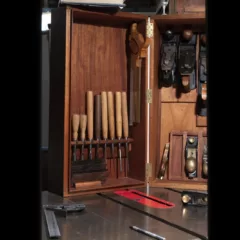Mouse. My transitional object.
A stuffed animal sewn by my paternal aunt and given to me at birth.
Fabric. From my aunt, given to my mother so she could repair Mouse.
–Scott Kip, “Objects”
We glance briefly at a smiling ceramic elephant on a glossy white postcard promoting Scott Kip’s (1974- ) Transitional Objects (2015) as we walk down the cluttered hallway past the other galleries’ metal doors and enter Marginal Utility Gallery, an exhibition space the artist completely transformed. The room is dark and quiet. Everything is colored and textured by time, awash in the patina of long-term use. A stack of postcards and a printout with long list of materials are the only framework offered as we cross the threshold into the work.
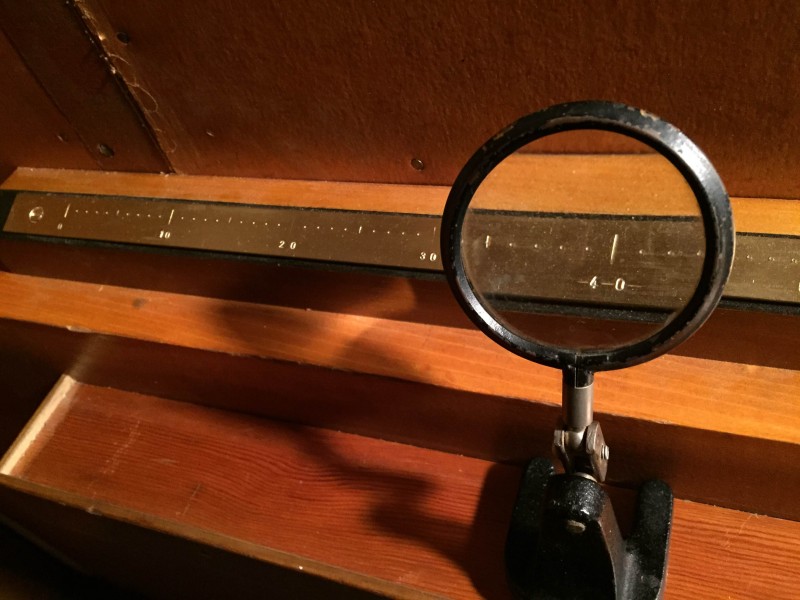
Rumination Mirror
In the entryway, there is a small square of bare floor and a few stairs to our left. As we ascend, we notice that the walls are made from the outsides of shipping crates, marked to indicate their contents and where they have been sent. We puzzle over being both in and outside of a box as we reach a landing.
There is a window in a wall with a looking-glass behind it that Kip refers to as the “rumination mirror,” a hybrid window-mirror that directs our gaze. We can faintly see our reflection in the window. On the windowsill, there is a stamped brass timeline that reads from left to right; a small magnifying glass moves along its length. We slide the magnifying glass and something beyond the window buzzes to life and a series of jerky movements make the mirror, about the size of the window, slide away from us on a track.
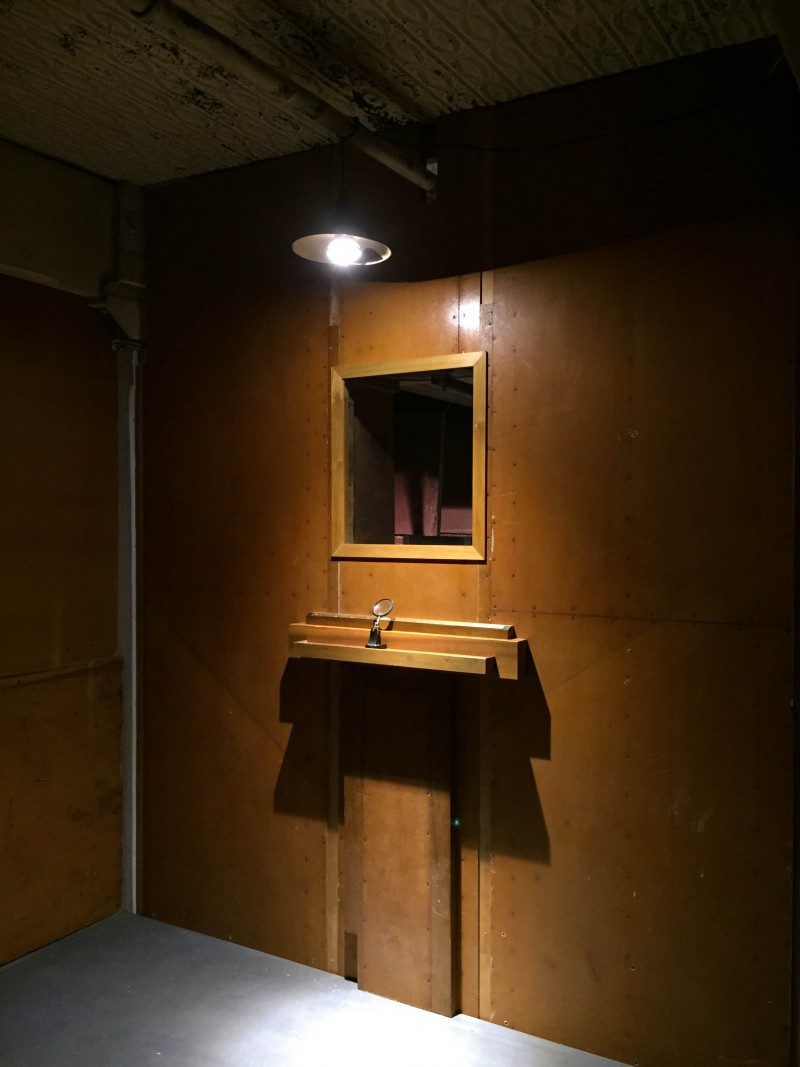
Moving the magnifying glass triggers four spotlights that reveal four objects that appear suspended in succession above a large, dark central space. Each object represents a decade in Kip’s 40-year life: the ceramic elephant (a bank the artist received as a baby), a tin drum (a possible reference to author Günter Grass), a cheese grater (from an unrequited love), and an elevation drawing of the Wanamaker organ (which the artist tends). With the mirror at its farthest distance, we can see more of the dimly lit space beyond the window; it appears domestic but staged.
While standing before the rumination mirror, we confront the instability of our sense of sight as we encounter something familiar—our hazy reflection—to find that the attempt to see ourselves is met with an unexpected visual experience. Through a window, which generally provides a frame of reference and allows for a sweeping view of an interior space, we gather elusive references. Similar to the mirror in the background of Diego Velazquez’s “Las Meninas” (1656) that substantiates the presence of our gaze, as Michel Foucault has argued, Kip’s window-mirror acknowledges our perspective as an organizing factor of meaning, yet suspends our visual entry.
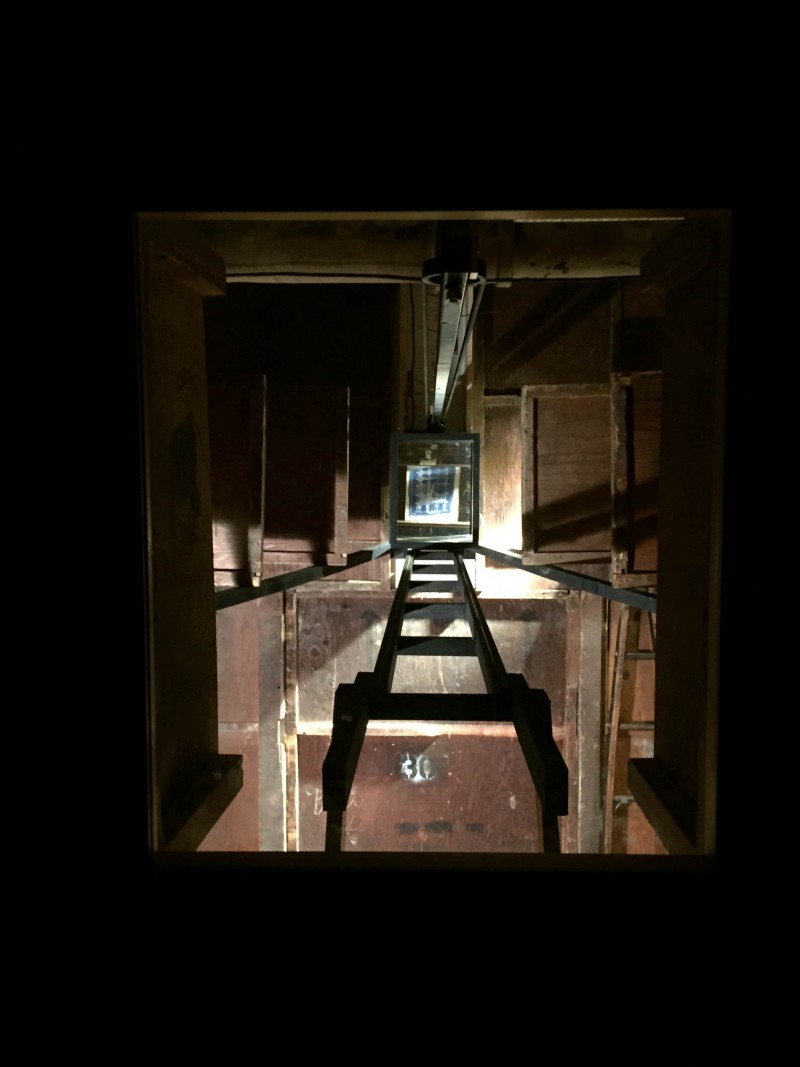
Although the stamped brass timeline on the windowsill provides an increment of measure (the four decades of the artist’s life), we lose a sense of scale and distance, as we cannot scan the space in which the objects lie to comprehend their unity. The artist has us shift from the subjective (an image of ourselves) and into the objective (the artist’s belongings) through reflections.
With the magnifying glass, an object typically used to see minutiae, Kip paradoxically dissolves a point of fixation and asks us to reconsider how we construct knowledge through stuff. In so doing, our perception becomes destabilized, metaphorically underscoring how we come to know things mediated through visual devices, which, although they are meant to help us understand something, can obscure meaning. We neither ruminate on our reflections nor on his things, but on the somewhat distressing act of being unable to clarify a focused point.
Objects
To the right of the window, we turn to enter another room. The floor rises and we find our heads near the ceiling and notice flaking paint and rust, usually imperceptible from the ground floor of Marginal Utility. Hanging on a wall is a wooden cabinet of incredibly fine workmanship with the proportions of a clock. Instead of a clock-face, it contains a piece of paper lying flat, devoid of numbers and with a little speck of something (a ball of ferrous metal, perhaps?). Opening a tiny cabinet drawer sets the speck in a continuous circular motion, producing an ever-thickening line that proves that time has passed. Kip’s work suggests that measurements of time can be tracked with, in this case, the pull of the drawer. Our way-finding markers in this already confusing space reside in the use of an object itself.
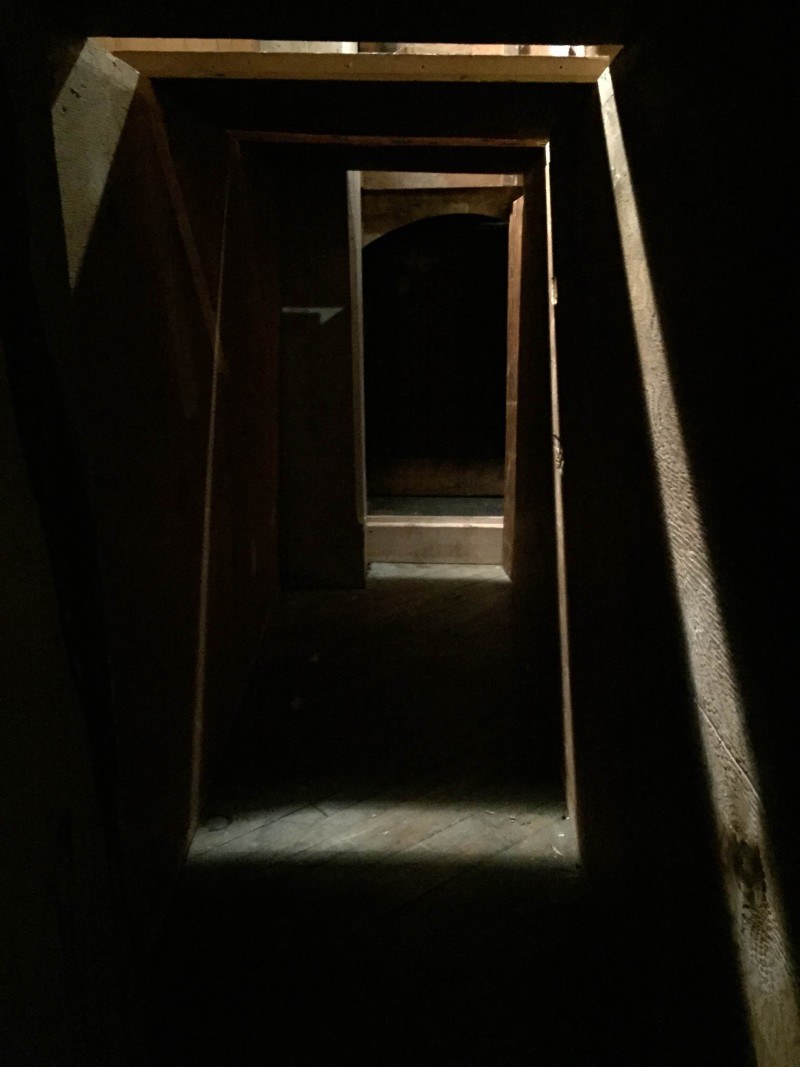
To exit the space with the clock-like cabinet, there is a ladder descending through a square opening in the floor. The climb down is the first physically and psychologically challenging task Kip asks of us, and it provokes hesitation. Once we descend, there is no room to stand, so we crouch to move forward. The space grows darker, and the passage narrower. There are small cutouts and gaps in a wall through which we can see into a larger area below us, which is in the center of the installation. We notice that the four objects we initially met are arranged below. They are not where we thought they would be; through the window-mirror, we had seen their reflections. They actually rest among sketchbooks, model trains, a Cub Scout photo of a young Kip, skateboard decks, books, a table, parrot feathers, and more possessions—a requiem of things he has accumulated since birth. These are his transitional objects, items to which he grew attached, on which he projected meaning, and that gave him comfort or provided inspiration throughout his life.
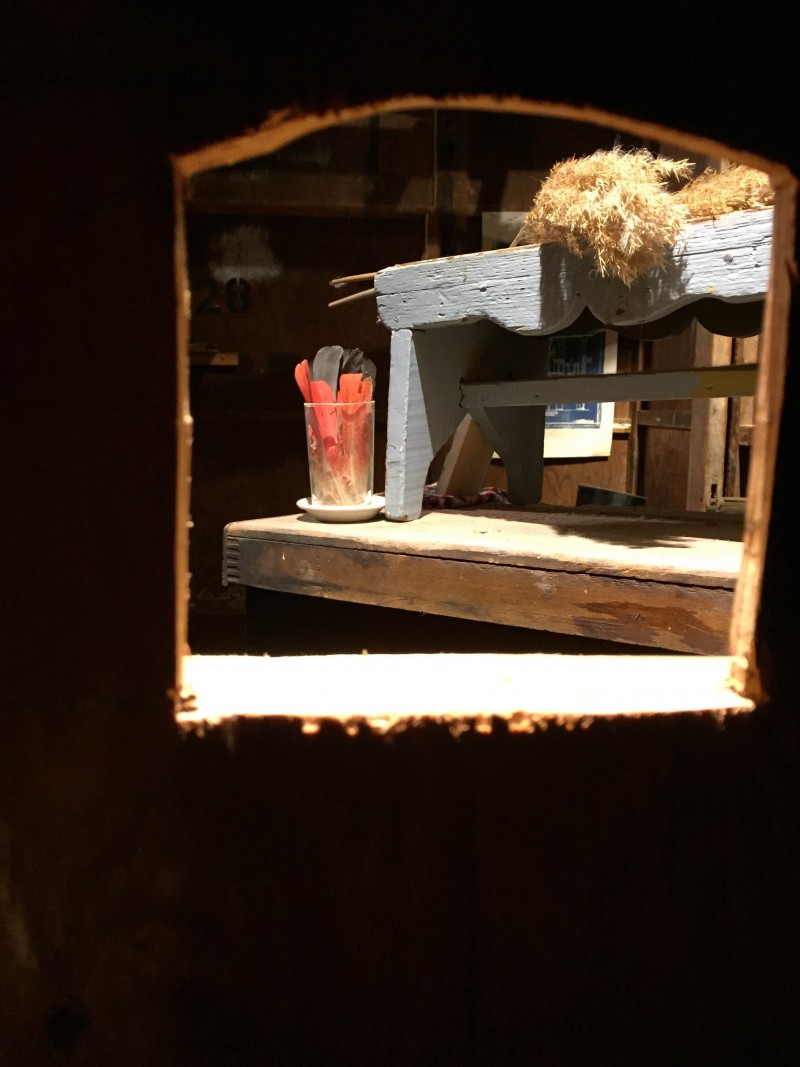
To see them, Kip requires us to climb down and crouch low, keeping us in a liminal space outside of the large central area. Looking through peepholes of varying sizes and slender gaps, we gain a sense of what lies within the inaccessible room, but obliquely. Kip denies a complete picture, a comprehensive visual intake, halting a sense of the extensive collection of things and generating a distance between us and his objects. In these ways, Transitional Objects problematizes how we look at saved items and challenges our perception of the familiar, emotionally charged objects we habitually encounter and with which we come to identify.
Still in darkness, we hear the mirror moving again—someone else has entered the space. Looking through the window-mirror, we believed that we were the voyeurs, trying to see Kip’s items from an elevated vantage point. The audible noise of the moving mirror makes us aware that someone else may be looking at us. This shift, from observer to observed, evokes the experience of Marcel Duchamp’s “Étant donnés” (1946-66), a rubbing of which Kip made in 2001 and placed among his objects. From the texture of Kip’s work-on-paper, it appears that he captured the texture of the double-door from the installation, implying the experience of viewing.
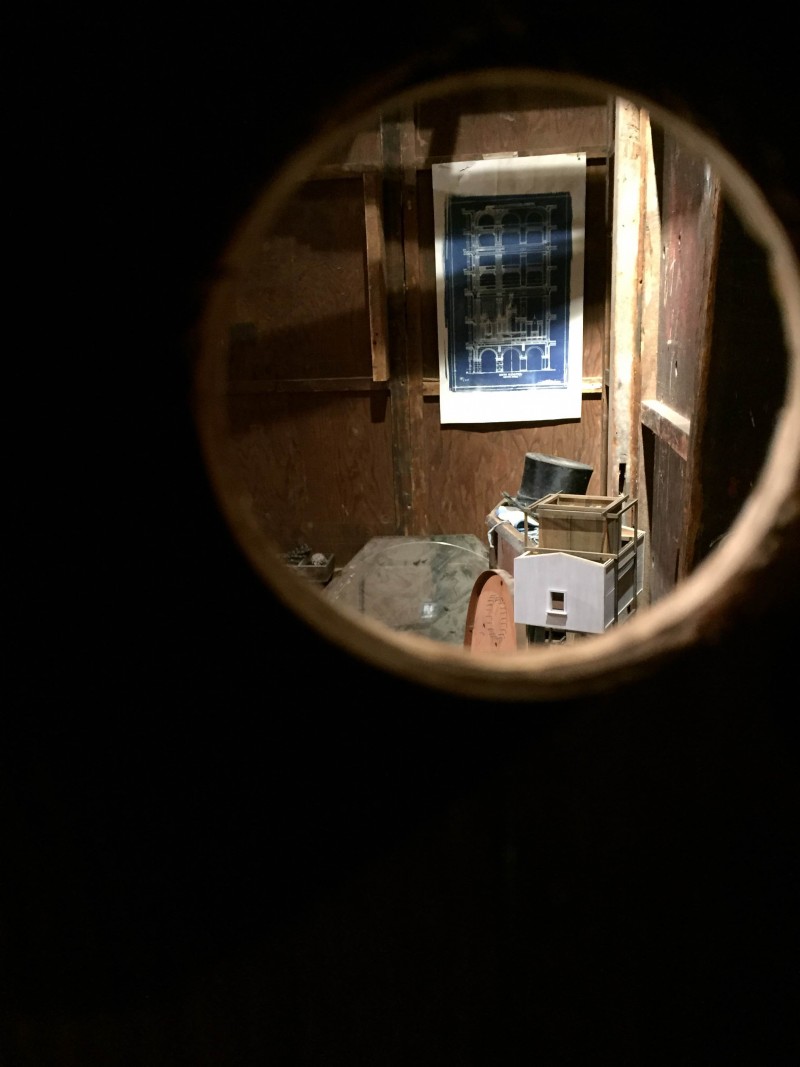
Standing before “Étant donnés” (at the Philadelphia Museum of Art), we look through two eye-level holes in the double door at a disturbing and perplexing scene. In the “Étant donnés” installation, if someone enters to wait behind us, he watches us look and we become the object of his gaze as we attempt to make sense of Duchamp’s work. Whereas Duchamp’s seemingly decapitated figure addressed the intersection of violence and sexual desire, Kip points us toward sincere longing and reflection. In terms of the viewer’s position as an object of the gaze, Kip’s installation departs from Duchamp’s in that it negates the possibility of our objective position as we remain marginalized and out of the sightline of someone before the window-mirror. Like the objects, we are hidden from view. By impeding the exchange between subject and object, we cannot rely on patterns of vision. Kip’s work disrupts the security we find in customary modes of seeing and being seen.
The Unattended Death
After we look through the peepholes, we turn a sharp corner and it seems like we cannot move forward. Crawling, we arrive at what may be the dead end of the passage, but it gives a little. With another push, the tunnel opens up into a hallway. And, once again, we are standing. We look back to see that we have come through a wooden cabinet. On its door, a framed cross-stitch sampler commemorating Kip’s birth hangs crookedly, the artist’s symbolic signature on the passageway from which we have just emerged.
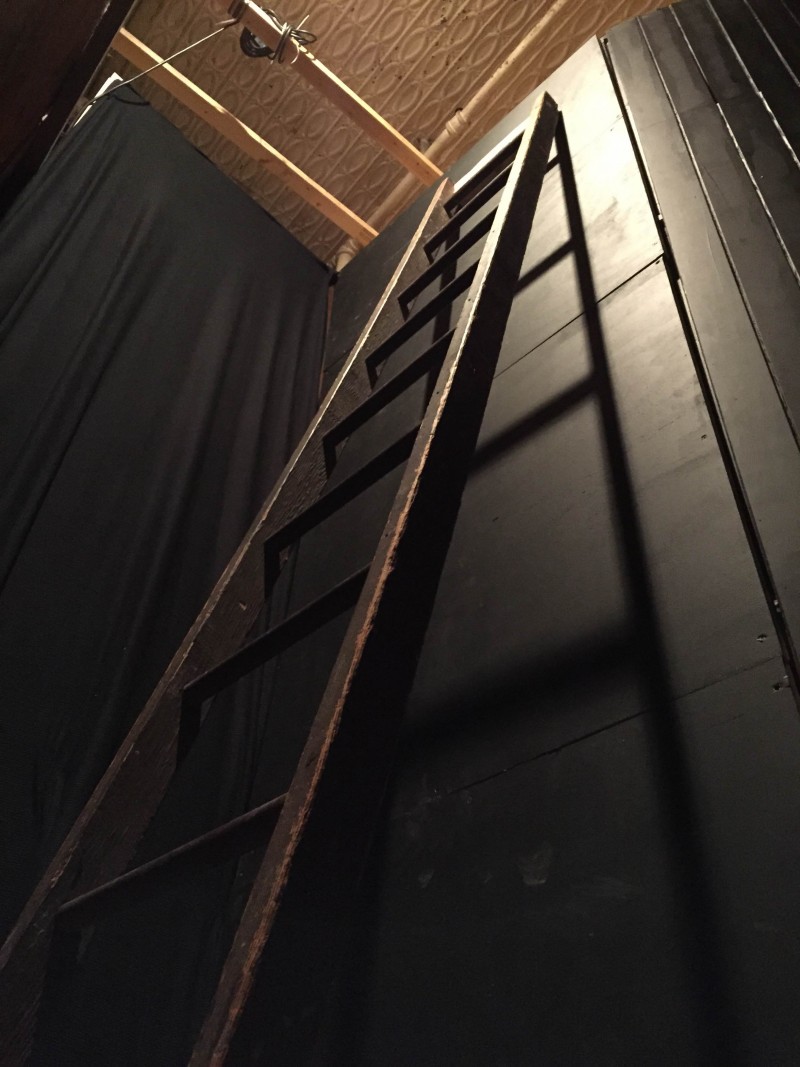
The walls to our left are draped in black fabric, and on the right, tall, vertical black wooden planks conceal another space. There are slight gaps between the boards, allowing light to bleed through, but they are not wide enough to see what awaits. The wall curves to the right and the passage becomes restrictive. We squeeze around the corner, tracing the curve with our hands, trying to see between the boards. We come to a ladder propped against the wall, inviting our ascent. From the ladder’s top step, we assume an unusually high position. Looking down into a well-lit ellipsoidal room, we see an eviscerated chair on a brightly colored rag rug. A floor lamp illuminates the space and a crate repurposed as a side table holds a rotary phone with the handset carelessly strewn on the floor. The scene, which Kip titles “The Unattended Death,” is both warm and haunting.
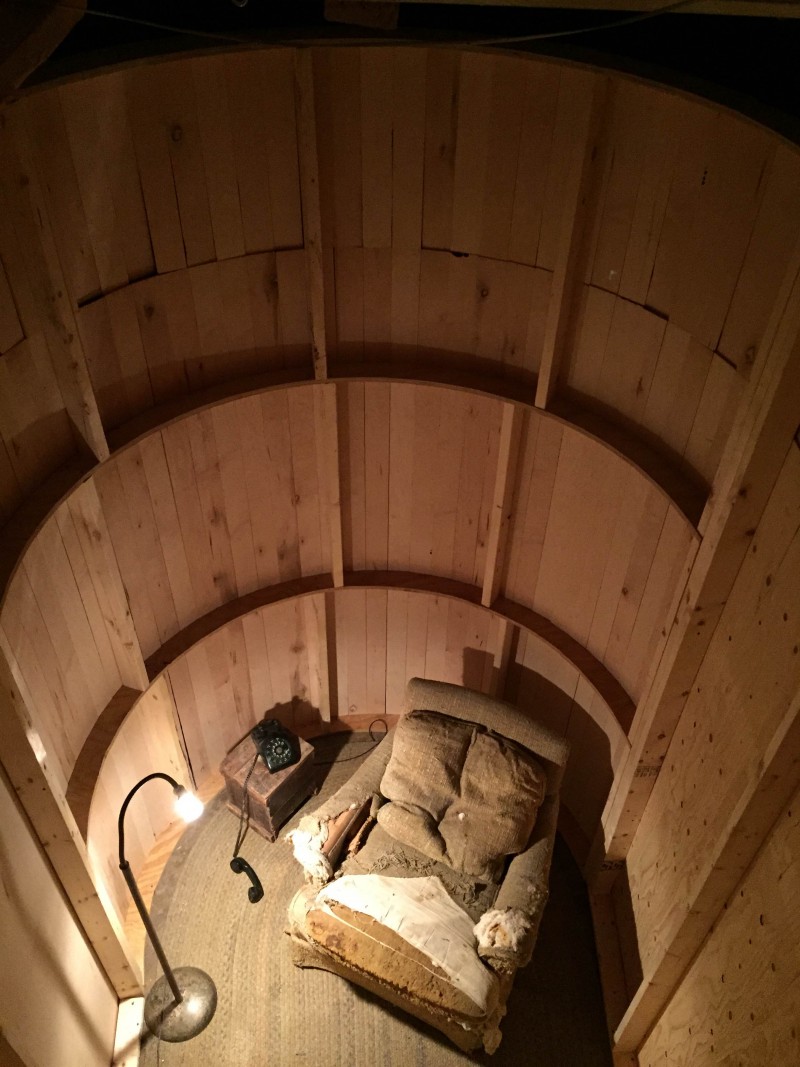
Thus far, we have not been able to see a complete vista. Peering over the side satisfies some resolve, but not entirely, as there is no way to gain entry and we are again kept at a distance, unable to touch the items. We glimpse the remnants of a once-inhabited room, which resides outside of the view of the window-mirror, beyond the reach of the timeline, and unmediated by viewing devices. As with the clock-like cabinet, we recognize that we can mark time through an item’s use, implied here in the torn and tattered fabric on the chair and rug. Unlike a vanitas in which we are faced with symbols of transience—a skull, a burning candle, an hourglass—lived-in objects convey a sense of loss. Here, we observe a metaphoric death surrounded by the materials that remain to commemorate an embodied life.
Throughout the installation, we are provided with viewing devices that allow us to look closely, while we are kept away from the objects we observe. We glimpse at familiar things that offer security, but the work’s constricting passageways foster a sense of anxiety. We finally arrive at a scene we can visually comprehend with an unobstructed view, but we are met with a dichotomy between comfort and tragedy. Our visual processes are hindered, and our tactile experiences impeded. Disrupting our sense of sight and ability to touch, Kip suggests that constructing the familiar is a habit of our senses. In upsetting our patterns, he causes us to acknowledge that we build our worlds through objects that nourish the tendencies of routine. In the absence of direct interaction with Kip’s objects, our perception is constructed through representational filters, leaving us with a hazy understanding, like the images encountered in the rumination mirror.
Transitional Objects is on view at Marginal Utility from September 4 – October 25, 2015.
Alexander Rosenberg is a Philadelphia-based artist, educator, and writer. He received a BFA in glass from Rhode Island School of Design and Master of Science in Visual Studies from MIT. His artistic practice is rooted in the study of glass as a material, in conjunction with broad interdisciplinary investigation crossing over into many other media and research areas.
Christa DiMarco recently completed her dissertation—Painting in Paris: Vincent van Gogh: 1886-1888—at Tyler School of Art, Temple University. She is also an assistant professor of humanities at the University of the Arts, where she teaches writing and art history.





